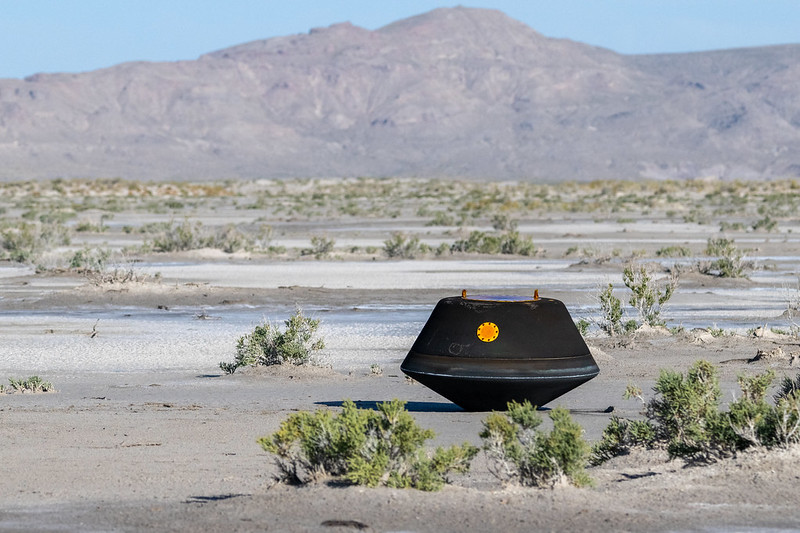Theme:
- On 24 September 2023, the OSIRIS-REx spacecraft delivered the sample it collected from the asteroid Bennu to Earth using the sample capsule.
OSIRIS-REx:
- In September 2016, NASA’s OSIRIS-REx (Origins, Spectral Interpretation, Resource Identification, Security, Regolith Explorer) spacecraft was sent to collect samples from the asteroid Bennu. Bennu is located approximately 8 crore kilometres away from Earth.
- In 2018, OSIRIS-REx reached Bennu and spent about two years orbiting the asteroid before collecting a 250-gram sample with its robotic arm in 2020, which was safely stored in the Sample Capsule.
- After storing the sample, the OSIRIS-REx spacecraft travelled back towards the Earth and when it was at a distance of 1 lakh kilometres from the Earth, it released the Sample Capsule. The capsule successfully landed in the Utah desert of the United States.
- Initial analysis of the sample revealed evidence of high carbon content and water.
Purpose of this mission:
- It is believed that carbon-rich asteroids like Bennu, which contain organic molecules and water may have crashed into the earth 4 billion years ago and could have been involved in the origin of life on Earth. So, by studying this sample, we can find clues about the origin of life on Earth.
- As Bennu is 4.5 billion years old, the sample may reveal clues about the birth of our solar system.
- Studying the Bennu sample can help us analyse the practicality of asteroid mining.
Why Bennu?
- Asteroid belt is approximately 40 crore kilometres away from Earth, situated between the orbits of Mars and Jupiter. Bennu is closer to Earth when compared with the asteroid belt. Currently, Bennu is at a distance of about 10 crore kilometres from Earth. It passes close to Earth every 6 years. So, it offers a cost-effective and less time-consuming option for exploration when compared with asteroids situated in the asteroid belt. Bennu may have formed in the asteroid belt, but gradually, it drifted away from that region.
- Moreover, Bennu is a carbon-rich asteroid, which contains organic molecules and water. So, studying this can help us understand about the origin of life.
OSIRIS-APEX:
- OSIRIS-REx didn’t end its journey after delivering the sample of Bennu to Earth. After dropping the sample capsule, it started travelling towards the asteroid Apophis to study it and has now been renamed OSIRIS-APEX. Apophis is expected to come relatively close to Earth in 2029, at a distance of 30,000 kilometres. These types of asteroids are referred to as Near Earth Asteroids (NEA).
- The possibility of an impact event with Earth from an asteroid, occurring between the years 2178 and 2290 is estimated to be 0.057%. These types of asteroids that have a potential impact risk are referred to as “Doomsday asteroids“. Monitoring and studying such asteroids is essential for planetary defence and understanding potential threats to our planet.
- OSIRIS-APEX aims to study their direction and spin rate changes. By studying this, we can learn to change the path of Doomsday asteroids or to destroy them altogether to protect our planet.
Conclusion:
OSIRIS-REx delivered a sample it collected from the Bennu asteroid to Earth. Initial analysis of this sample revealed evidence of high carbon content and water. Thoroughly studying this can give us clues about the origin of life on Earth, the origin of the solar system and also about the possibility of asteroid mining.
Your Turn…
What are your thoughts on OSIRIS-REx? Express your views through the comment section below. Subscribe to our blog to read answers to the trending GD topics.
Photo Credit: NASA/Keegan Barber
References:
- ‘పుడమిని చేరింది… ఏం చెప్పనుంది?’ article in Eenadu newspaper.
- ‘Cosmic curio: A little bit of Bennu’ by ‘Dilip D’Souza’ in Mint newspaper
- ‘How important is the first asteroid sample’ by ‘Prakash Chandra’ in the Hindu newspaper.
Copyright @ Group Discussion Ideas.

